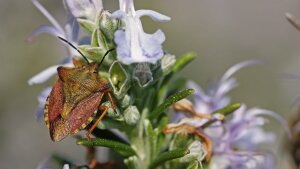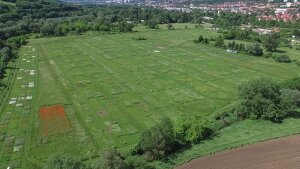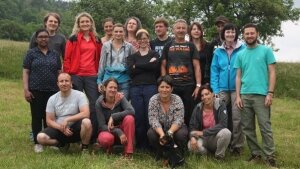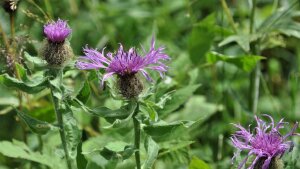-
Research
Learn moreOur group covers three main lines of research, all united by the interest in understanding population-level biodiversity and its consequences for intra- und inter-species population dynamics. (i) trophic interactions and community dynamisc are the focus of Community Population Ecology line of research. (ii) Local adaptation, temporal population dynamics and behavioural ecology are the focus of Evolutionary Population Ecology line of resaerch. (iii) And the genomic architecture of genetic polymorphisms, speciation and hybridization are the focus of Molecular Population Ecology line of resarch. Furthermore, we are interested in (iv) ecological, evolutionary and startistical methods and therefore also cover the field that we call Population Ecology Methods.
-
Projects
Learn moreContemporary scientific work is often very collaborative. We are therefore involved in several large collaborative research project. This includes the long-running Jena ExperimentExternal link that was established in 2002 and has been DFG-funded since then. More recently, we got engaged in a NC3 Collaborative Research CenterExternal link that is also funded by the DFG and studies the evolutionary ecology of individualized niches. Furthermore, we are participating in the German Centre for Integrative Biodiversity Research (iDiv)External link in Halle-Jena-Leipzig, the Michael Stifel Center Jena (MSCJ)External link for Data-Driven & Simulation Science and the Interantional Max Planck Research School (IMPRS)External link run by Max Planck Institute for Chemical Ecology in Jena. Additionally, we are involved in more grass-roots projects such as the Nutrient Network (NutNet)External link and the team for the Statistical Quantification of Individual Differences (SQuID)External link. And finally, there are always ongoing individually funded projects that are also important.
-
Team
Learn moreWe are a team of currently six postdoctal researchers, three PhD students, five technical assistants, and four gardeners. We will occasionally solicit applications for funded PhD student positions. Furthermore, if you are interested in joining the group with external funding or as part of your studies, you may contact us at popecol@uni-jena.de.
-
Teaching
Learn moreWe offer a variety of classes for the BSc level in Biology and the MSc level in Ecology, Evolution and Systematics. The topics range from introduction to faunistic field methods, evolutionary, community and conservation ecology, via population genetics to scientific writing and presentations. We also continously offer a selection of topics for Bachelor or Master projects. The list of ongoing and completed projects gives an impression about the range of topcis that we offer. Please to not hesitate to contact us if you are interested and movitated to work in the field of evolutiony, molecular or community ecology.
-
Recent publications
Learn moreBröcher, M., Meyer, S.T., Eisenhauer, N. & Ebeling, A. (2024). The positive plant diversity-consumer relationship is independent of grassland age. Basic and Applied Ecology doi: 10.1016/j.baae.2024.02.006External link
Wildermuth, B., Hagge, J., Seifert, C.L., Tjaden, R. & Schuldt, A. (2024). Beneficial effects of native broadleaved forests on canopy beetle diversity are not reduced by admixture of non-native conifers. Journal of Applied Ecology doi: 10.1111/1365-2664.14623External link
Wildermuth, B., Penanhoat, A., Sennhenn-Reulen, H., Matevski, D., Drescher, J., Aubry-Kientz, M., Seidel, D. & Schuldt, A. (2024). Canopy structure influences arthropod communities within and beyond tree identity effects: Insights from combining LiDAR data, insecticidal fogging and machine learning regression modelling. Ecological Indicators 160: 111901. doi: 10.1016/j.ecolind.2024.111901External link
Dietrich, P., Ebeling, A., Meyer, S.T., Bonato Asato, A.E., Bröcher, M., Gleixner, G., Huang, Y., Roscher, C., Schmid, B., Vogel, A. & Eisenhauer, N. (2024). Plant diversity and community age stabilize ecosystem multifunctionality. Global Change Biology doi: 10.1111/gcb.17225External link
Medina-van Berkum, P., Schmöckel, E., Bischoff, A., Carrasco-Farias, N., Catford, J.A., Feldmann, R., Groten, K., Henry, H.A.L., Bucharova, A., Hänniger, S., Luong, J.C., Meis, J., Oetama, V.S.P., Pärtel, M., Power, S.A., Villellas, J., Welk, E., Wingler, A., Rothe, B., Gershenzon, J., Reichelt, M., Roscher, C. & Unsicker, S.B. (2024). Plant geographic distribution influences chemical defences in native and introduced Plantago lanceolata populations. Functional Ecology doi: 10.1111/1365-2435.14535External link
Güney, G., Cedden, D., Hänniger, S., Hegedus, D.D., Heckel, D.G. & Toprak, U. (2024). Peritrophins are involved in the defense against Bacillus thuringiensis and nucleopolyhedrovirus formulations in Spodoptera littoralis (Lepidoptera: Noctuidae). Insect Biochemistry and Molecular Biology 166: 104073. doi: 10.1016/j.ibmb.2024.104073External link
Zheng, L., Barry, K.E., Guerrero-Ramírez, N.R., Craven, D., Reich, P.B., Verheyen, K., Scherer-Lorenzen, M., Eisenhauer, N., Barsoum, N., Bauhus, J., Bruelheide, H., Cavender-Bares, J., Dolezal, J., Auge, H., Fagundes, M.V., Ferlian, O., Fiedler, S., Forrester, D.I., Ganade, G., Gebauer, T., Haase, J., Hajek, P., Hector, A., Hérault, B., Hölscher, D., Hulvey, K.B., Irawan, B., Jactel, H., Koricheva, J., Kreft, H., Lanta, V., Leps, J., Mereu, S., Messier, C., Montagnini, F., Mörsdorf, M., Müller, S., Muys, B., Nock, C.A., Paquette, A., Parker, W.C., Parker, J.D., Parrotta, J.A., Paterno, G.B., Perring, M.P., Piotto, D., Wayne Polley, H., Ponette, Q., Potvin, C., Quosh, J., Rewald, B., Godbold, D.L., van Ruijven, J., Standish, R.J., Stefanski, A., Sundawati, L., Urgoiti, J., Williams, L.J., Wilsey, B.J., Yang, B., Zhang, L., Zhao, Z., Yang, Y., Sandén, H., Ebeling, A., Schmid, B., Fischer, M., Kotowska, M.M., Palmborg, C., Tilman, D., Yan, E. & Hautier, Y. (2024). Effects of plant diversity on productivity strengthen over time due to trait-dependent shifts in species overyielding. Nature Communications 15: 2078. doi: 10.1038/s41467-024-46355-zExternal link
Bassi, L., Hennecke, J., Albracht, C., Bröcher, M., Solbach, M.D., Schaller, J., Doan, V., Wagner, H., Eisenhauer, N., Ebeling, A., Meyer, S.T., van Dam, N.M. & Weigelt, A. (2023). Uncovering the secrets of monoculture yield decline: trade-offs between leaf and root chemical and physical defence traits in a grassland experiment. Oikos 2023: e10061. doi: 10.1111/oik.10061External link
Huang, Y., Stein, G., Kolle, O., Kübler, K., Schulze, E.-D., Dong, H., Eichenberg, D., Gleixner, G., Hildebrandt, A., Lange, M., Roscher, C., Schielzeth, H., Schmid, B., Weigelt , A., Weisser, W.W., Shadaydeh, M., Denzler, J., Ebeling, A. & Eisenhauer, N. (2023). Enhanced stability of grassland soil temperature by plant diversity. Nature Geoscience doi: 10.1038/s41561-023-01338-5External link
Körnig, J., Ortizo, K., Sporer, T., Yang, Z.L. & Beran, F. (2023). Different myrosinases activate sequestered glucosinolates in larvae and adults of the horseradish flea beetle. Insect Biochemistry and Molecular Biology 163: 104040. doi: 10.1016/j.ibmb.2023.104040External link
Chen, Q., Wang, S., Borer, E.T., Bakker, J.D., Seabloom, E.W., Harpole, W.S., Eisenhauer, N., Lekberg, Y., Buckley, Y.M., Catford, J.A., Roscher, C., Donohue, I., Power, S.A., Daleo, P., Ebeling, A., Knops, J.M.H., Martina, J.P., Eskelinen, A., Morgan, J.W., Risch, A.C., Caldeira, M.C., Bugalho, M.N., Virtanen, R., Barrio, I.C., Niu, Y., Jentsch, A., Stevens, C.J., Gruner, D.S., MacDougall, A.S., Alberti, J. & Hautier, Y. (2023). Multidimensional responses of grassland stability to eutrophication. Nature Communications 14: 6375. doi: 10.1038/s41467-023-42081-0External link
Gikonyo, M.W., Ahn, S.-J., Biondi, M., Fritzlar, F., Okamura, Y., Vogel, H., Köllner, T.G., Şen, I., Hernández-Teixidor, D., Lee, C.-F., Letsch, H. & Beran, F. (2023). A radiation of Psylliodes flea beetles on Brassicaceae is associated with the evolution of specific detoxification enzymes. Evolution doi: 10.1093/evolut/qpad197External link
Varma, M., Winter, G., Rowland, H.M. & Schielzeth, H. (2023). Ontogeny of color development in two green-brown polymorphic grasshopper species. Ecology and Evolution doi: 10.1002/ece3.10712External link
Letsch, H. & Beran, F. (2023). Jumping to new hosts: the diversification of flea beetles (Coleoptera: Chrysomelidae: Alticini) in the context of their host plant associations. Insect Systematics and Diversity 7: 2.1-12. doi: 10.1093/isd/ixad019External link
Li, Z.Y., Costamagna, A.C., Beran, F. & You, M.S. (2023). Biology, ecology and management of flea beetles in Brassica crops. Annual Review in Entomology 69: (in press).
Bakker, J.D., Price, J.N., Henning, J.A., Batzer, E.E., Ohlert, T.J., Wainwright, C.E., Adler, P.B., Alberti, J., Arnillas, C.A., Biederman, L.A., Borer, E.T., Brudvig, L.A., Buckley, Y.M., Bugalho, M.N., Cadotte, M.W., Caldeira, M.C., Catford, J.A., Chen, Q.Q., Crawley, M.J., Daleo, P., Dickman, C.R., Donohue, I., DuPre, M.E., Ebeling, A., Eisenhauer, N., Fay, P.A., Gruner, D.S., Haider, S., Hautier, Y., Jentsch, A., Kirkman, K., Knops, J.M.H., Lannes, L.S., MacDougall, A.S., McCulley, R.L., Mitchell, R.M., Moore, J.L., Morgan, J.W., Mortensen, B., Venterink, H.O., Peri, P.L., Power, S.A., Prober, S.M., Roscher, C., Sankaran, M., Seabloom, E.W., Smith, M.D., Stevens, C., Sullivan, L.L., Tedder, M., Veen, G.F., Virtanen, R. & Wardle, G.M. (2023). Compositional variation in grassland plant communities. Ecosphere 14: e4542. doi: 10.1002/ecs2.4542External link
Garbowski, M., Boughton, E., Ebeling, A., Fay, P., Hautier, Y., Holz, H., Jentsch, A., Jurburg, S., Ladouceur, E., Martina, J., Ohlert, T., Raynaud, X., Roscher, C., Sonnier, G., Tognetti, P.M., Yahdjian, L., Wilfahrt, P. & Harpole, S. (2023). Nutrient enrichment alters seasonal β-diversity in global grasslands. Journal of Ecology doi: 10.1111/1365-2745.14182 doi: 10.1111/1365-2745.14182External link
Argens, L., Weisser, W.W., Ebeling, A., Eisenhauer, N., Lange, M., Oelmann, Y., Roscher, C., Schielzeth, H., Schmid, B., Wilcke, W. & Meyer, S.T. (2023). Relationships between ecosystem functions vary among years and plots and are driven by plant species richness. Oikos doi: 10.1111/oik.10096External link
Mutwill, A.M., Schielzeth, H., Richter, S.H., Kaiser, S. & Sachser, N. (2023). Conditional on the social environment? Roots of repeatability in hormone concentrations. Hormones and Behavior doi: 10.1016/j.yhbeh.2023.105423External link
Pick, J.L., Kasper, C., Allegue, H., Dingemanse, N., Dochtermann, N.A., Laskowski, K.L., Lima, M.R., Schielzeth, H., Westneat, D.F., Wright, J. & Araya-Ajoy, Y.G. (2023). Describing posterior distributions of variance components: Problems and the use of null distributions to aid interpretation. Methods in Ecology and Evolution (in press) doi: 10.1111/2041-210X.14200External link
Singh, P., Wolthaus, J., Schielzeth, H. & Müller, C. (2023). State-dependency of behavioural traits is a function of the life-stage in a holometabolous insect. Animal Behaviour 203: 29-39. doi: 10.1016/j.anbehav.2023.06.013External link
Winter, G., Wirsching, L. & Schielzeth, H. (2023). Condition-dependence of (un)predictability in escape behavior of a grasshopper species. Behavioral Ecology doi: 10.1093/beheco/arad047External link [Data availability]External link [Code availability]External link
Dornburger Str. 159
07743 Jena
Google Maps site planExternal link




